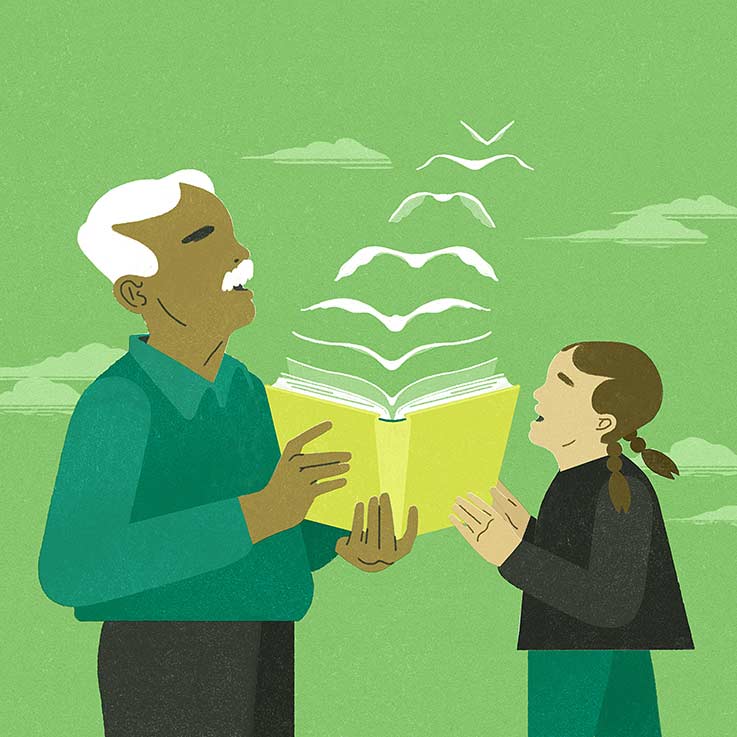
The Two-Way Benefits of Local, Intergenerational Classroom Support
The Two-Way Benefits of Local, Intergenerational Classroom Support
Four ways classroom tutoring support can improve education while increasing the well-being of young and older populations in underserved communities.
By Dawn Purnell, D’Ann Morris & Teresa Seeman Apr. 19, 2021
Strong academic preparation is essential to college participation and the upward mobility, economic security, and quality of life that tend to follow. This is particularly true for students of color attending under-resourced and underserved schools, and it begins with reading. According to a report by the Annie E. Casey Foundation, roughly 16 percent of children in the United States who don’t read proficiently by the end of third grade do not graduate on time—a rate four times higher than for proficient readers. Local statistics frequently tell a similar story. According to data from the California Department of Education, for example, in 2015, less than 35 percent of third-grade students in Los Angeles Unified School District were meeting or exceeding English language standards, and nearly 25 percent were failing to graduate from high school or dropping out.
While early reading proficiency and higher education are essential to young people achieving long-term quality of life, health is a key factor in the quality of life of older adults. A lack of social, cognitive, and physical activity have a direct tie to diminished cognitive function; reduced independence; increased risk of falls and fractures; and increased rates of disability, hospitalizations, and death.
Meeting the Multigenerational MomentThis essay series, presented in partnership with Encore.org and The Eisner Foundation, explores how fresh thinking and new social arrangements hold the potential to make the most of an increasingly multigenerational society.FOLLOW THIS SERIES
Like most nonprofits, funders, policy makers, and professionals typically propose separate solutions for the problems these two groups face. Educators suggest enrichment and remediation for enhancing academic outcomes; health care professionals propose diet, exercise, and other medical interventions for improving health outcomes for older adults. However, as other essays in this series have discussed, age-segregated solutions overlook the profound ways in which young and older individuals can benefit from mutual engagement—young people from extra support, older adults from healthy activity and engagement in meaningful societal roles. Tutoring support in the classroom is no exception. An intergenerational approach where older adults step in to help students learn can benefit both.
What Intergenerational Classroom Support Looks Like
There are many high-quality, local tutoring programs in the United States that engage older adults and young children, including Reading Partners and Oasis. There are also a few national programs, including AARP’s Experience Corps, which now operates in more than 22 cities, with tutors spending four hours or more hours each week working with students.
While these programs are incredibly valuable, students in under-resourced schools often need more sustained and community-centric support. With this in mind, we designed a classroom assistance program, Generation Xchange, that goes beyond the typical tutoring initiative, offering students and teachers direct and lasting classroom support. Generation Xchange launched in 2014 as a partnership between UCLA’s Department of Geriatrics at the David Geffen School of Medicine and the Los Angeles Unified School District. The program recruits retired adult volunteers age 50 and older from communities in South Los Angeles to assist and mentor students in local elementary schools.
Each volunteer receives 30 hours of training in early literacy, phonics, reading comprehension, mathematics, social-emotional support, behavior redirection, and stress management. From there, they spend at least 10 hours per week in an assigned K-3 classroom, working individually and in small groups to help students master grade-level English language and math standards, and to support greater levels of classroom engagement and quality instruction by addressing students’ social and emotional needs.
Since the program launched, teachers and principals in participating schools have reported better attendance by students, fewer discipline problems, and improvements in academic skills. In one school, the percentage of first graders who met reading standards nearly doubled, jumping from 38 percent to 77 percent in the first two years of the program.
Meanwhile, volunteers have seen real health benefits, including lower blood pressure and cholesterol levels, desirable weight loss, and faster walking speeds. Three-quarters of volunteers have increased their daily activity level by 20 to 40 percent, and half have increased the number of days they exercise by at least one day. What’s more, volunteers have developed friendships with other volunteers and have often helped each other through life crises. “I started out doing this for the kids,” said volunteer Virginia Martin, “but it has brought a lot of wealth to my life.”
Four Insights Into Making Local, Intergenerational Programs Work
Funded by ongoing philanthropic support, as well as financial commitments from several principals to support additional volunteers at their schools, today Generation Xchange has more than 60 active volunteers working in six elementary schools. During the 2019-2020 academic year, they contributed more than 17,000 hours of support to students and teachers.
We have learned a great deal from volunteers, educators, and students about what it takes to increase the impact of a program like this. For others interested in intergenerational solutions to improve education and well-being for young and older populations in underserved communities, we offer four insights:
1. Recruit Locally
Recruiting older volunteers from the same communities as the schools they serve has several advantages. First, volunteers have access to local resources that chronically underserved schools desperately need. Generation Xchange volunteer Linda Ricks, for example, enlisted the support of the children’s librarian at the Hyde Park Miriam Matthews Library to initiate programs at 74th Street Elementary, donate used books to the school’s library, and introduce students to the library’s homework center. She also got her local council district to sponsor an outdoor overnight trip for fifth-grade students and designate the school as a site for its National Walk to School Day. “It’s important that schools are connected to their community,” says Ricks. “It creates a sense of pride for students, and even parents, in their community when they know that these types of resources are available to them right here where they live.”
Second, older adults tend to be more civic-minded and politically engaged than other groups. Nearly 65 percent of Americans over age 65 voted in mid-term and four-year elections nationally and locally. Volunteers are more likely to make informed voting decisions in local school board elections and support bond initiatives that generate school funding. They’re also more likely to inform their neighbors about these issues and galvanize them to help. Helena Williams, a resident of the Windsor Hills community for more than 30 years, wasn’t involved with 54th Street Elementary until she volunteered for Generation Xchange. “Even though I could hear the children on the playground from my backyard, my children didn’t attend the school, so I didn’t give it much thought.” A new appreciation for the number of hats teachers and principals must wear to adequately support student development and the level of need students have in meeting grade-level standards has encouraged her to share what she’s learning with her neighbors and recruit retirees to join her in volunteering. She’s also started a nonprofit focused on supporting student achievement through her church and enlisted her former Generation Xchange teacher to join the board. According to Williams, “When you recruit from the community, you’re recruiting stakeholders. If I’m doing well, my community is doing well. If something is going wrong in my community, it’s just as much my responsibility to make it right.”
2. Provide Adequate Training to Volunteers and Teachers
Volunteers at under-resourced schools in low-income communities must receive training on academics and pedagogy, as well as emotional and behavioral issues. Programs shouldn’t expect volunteers to replace trained educators or mental health professionals, but training across all these areas makes them better equipped to help students. At Generation Xchange, volunteers receive 30 hours of training, including sessions on how to recognize trauma or abuse in students, and how to handle wandering attention spans. Volunteers also learn about how to handle their own emotional and psychological well-being.
Generation Xchange also helps teachers understand what they can and can’t expect from older classroom volunteers. All teachers receiving a volunteer go through an orientation process, where the primary message is that older volunteers are assigned to their classrooms to work with students, and shouldn’t spend their time grading tests or making copies of class materials.
3. Build Alliances With Educators at All Levels
Volunteers have to feel wanted to succeed. Principals, teachers, school board members, and senior staff all have roles to play, whether it’s committing to the program in the first place, directly encouraging volunteers, or assisting with fundraising.
In schools with high levels of principal and teacher support, Generation Xchange is deeply integrated into school activities and classroom structure. This happens over time. When first introducing volunteers into a school, we place them with teachers who understand how additional classroom support can accelerate learning. These educators often have a plan for which students to pair with volunteers, what resources they will provide to volunteers, and how much time they would like volunteers to spend reviewing teaching materials. Within a few months, teachers who may have hesitated to take on a volunteer hear about the benefits from colleagues and frequently request one of their own.
4. Watch for Unexpected Benefits
Over time, unexpected benefits and beneficiaries can emerge from education programs first and foremost designed to benefit students and older adults. And they can deepen everyone’s commitment—volunteers, teachers, and school administrators—to the program.
Teachers working with Generation Xchange, for example, have explained that volunteers have contributed to their own success with students. “Having that extra pair of hands in the classroom has allowed me to address student needs more easily,” said Dawn McGhee, a third-grade teacher. “I’ve been able to work with smaller groups and provide differentiated instruction on a regular basis.” Another teacher, Theresa Brisette, said that her volunteer, who previously ran a plant business, “played a vital role in enhancing our curriculum” when the class was learning about plants. Still other teachers say that if they happen to be ill or absent, they feel reassured knowing that the volunteer assigned to their class will be there for students, and in fact, a number of principals have said that some of their newest teachers might not have made it through the year without the help of their classroom volunteer.
The connections between teachers and volunteers aren’t limited to classroom issues either. Second-grade teacher Marion Johnson said about her volunteer, “Ms. Bernice cares all about every aspect of our students’ lives and my life. We talk nearly every day about everything! She has been irreplaceable both in my work life and personal life.” And one volunteer described the teacher she was assigned to as “my new best friend.”
Friendships also frequently develop between volunteers. At each school, the program provides a team of 10 or more volunteers that meet weekly to discuss how things are going, share accomplishments and challenges, and offer support and suggestions. With the onset of the COVID-19 pandemic, the teams have continued their weekly meetings on Zoom and launched other social activities, including book and movie clubs and shared virtual lunches. The regular meetings and social connections build abiding friendships and a sense of community, which, in turn, increases the health benefits for older volunteers.
Seeing Beyond Silos
Like many intergenerational programs, Generation Xchange defies easy categorization. In her book Friendship, science writer Lydia Denworth describes it as “an educational nonprofit wrapped in a community health initiative, with a loneliness intervention program beating quietly but steadily at its heart.” It has multiple and reinforcing benefits for students, teachers, school administrators, and communities. We are seeing a growing appreciation of the potential for local, older adults to make highly valued contributions to the school community—supporting both improved outcomes for students and teacher effectiveness—as well as health and well-being benefits for older adults. In light of the educational and wellness challenges so many US communities face today, the program illustrates how intergenerational engagement can provide compounded benefits to multiple segments of the population while addressing important societal needs.










